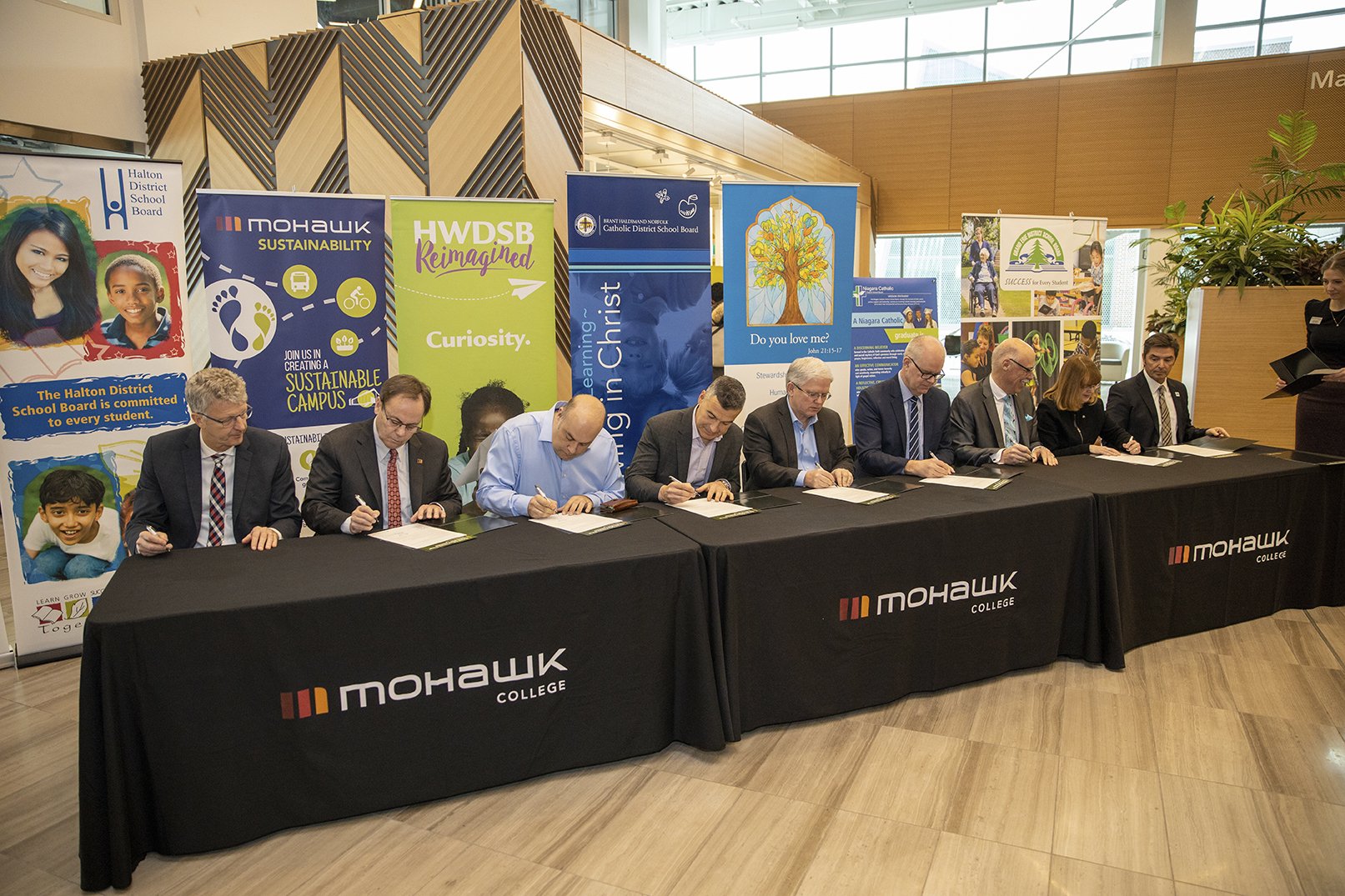
Climate Change Leaders
Our Compelling Vision
Our Difference

Our Plan
Collaboration is at the heart of how we develop, design and implement decisions and actions to transform school buildings to carbon neutral. We have purposely created this collaborative alliance to link together student experiential learning with technology transformation to evolve the school and classroom into a living lab possibility. Working together with school boards and colleges TCI will co-create a new future for students while substantially reducing greenhouse gas over a pre-determined timeline. Over the course of this journey we collectively will develop and support new learning opportunities for all students associated with new curriculum, dual credit programs, Specialized High Skills Major (SHSM) programs and student cooperatives. This effort will help support your community to develop the capacity and capability skill sets to support the transformational learning HUB.
Our flagship CCL Learning Hub is located in the greater Hamilton, Burlington and Niagara area including: Hamilton Wentworth District School Board, Halton Catholic District School Board, Grand Erie District School Board, Brant Haldimand Norfolk Catholic District School Board, Niagara Catholic District School Board, District School Board of Niagara, Conseil scolaire catholique MonAvenir, Conseil scolaire Viamonde and Mohawk College.
Additional CCL Hubs are being contemplated in London, Barrie, Ottawa, Sudbury and Timmins with local Colleges. The technology transformation will be led by an energy master plan and GHG roadmap to identify potential building system deep retrofits, optimize these systems building system analytics and finally develop on site renewable energy systems and micro grids.
Our Goal
Our goal is to help school boards and colleges achieve 45% carbon reduction by 2030 and carbon neutral by 2050, that aligns with the Paris Accord agreement and our Canadian Federal Government greenhouse gas (GHG) targets for educational buildings by implementing the Climate Change Leaders strategy.
Our Value Proposition
A pathway and expertise to meet the Paris Accord 2030 GHG reduction of 45% and net zero by 2050.
Improving the quality, energy resiliency and sustainability of public buildings.
Providing occupant health and wellness, safety, resiliency and responsible citizenry.

On February 11, 2020 Mohawk and the following school districts signed an memorandum of understanding (MoU) with the following principles:
Hamilton Wentworth District School Board
Halton Catholic District School Board
Grand Erie District School Board
Brant Haldimand Norfolk Catholic District School Board
Niagara Catholic District School Board
District School Board of Niagara
Conseil scolaire catholique MonAvenir
Conseil scolaire Viamonde
-

Learning
Building capacity and capability in clean technology and a low carbon community with new co-ops, specialized high skills majors, duel credits, research and engagement.
-

Carbon Reduction
Reducing carbon in our buildings and communities linking technology transformation with an education plan to facilitate and exceptional student experience.
-

Capital Investment
Being fiscally responsible stewards: develop demonstration projects using energy saved and energy made.

Mission
As a learning partnership, CCL focuses on transforming public buildings to a carbon-neutral; linking technology to student experiential learning to support tomorrow’s skills, capacity and capability to transform to a low carbon community.
Vision
To inspire youth with the purpose to enable communities to transform to a low carbon community.
Values
A sustainable future for our children.

Leadership
Lead by example, inspire others into action
Innovation
Make a difference – think outside the box
Collaboration/Inclusion
If you want to go fast go alone, if you want to go far go together
Contribution
Contribute to your community
Impact
Create change that promotes youth and community wellness
Respect
Respect the earth, others and yourself
Possibility
Unlock our full potential and the endless possibilities!

-
Our Education Plan brings inclusive opportunities to students to meet the needs of a growing green economy. With our team of experts in the education field, we provide a learning framework design that supports:
New student curriculum;
Experiential learning associated with STEAM (Science/Technology/Engineering/Arts/Math);
Dual-credit academic opportunities;
SHSM (Specialist High Skills Majors) programs; and
Student co-op possibilities
Our education partners work with a school board’s educational team representative to design and deliver the best possible program.
-
TCI understands that embarking on new ways of doing things can sometimes be a challenge for the school community. Our proven engagement framework reaches out to all learning-community participants: students, teachers, principals, staff, parents and the Board – to determine the issues that are important to them.
We view the engagement process as a continuous conversation designed to measure progress: how successful a program is, and how it is received by all stakeholders. Engagement allows us to align, refine and design adjustments to the strategic direction of the program to maximize inclusiveness and outreach, thereby ensuring that everyone is working towards a common goal.
-
TCI has over 20 years of combined communications experience in the K-12 and postsecondary education sectors.
We create customized communications plans designed to:
Enhance the understanding of a program,
Keep stakeholders up-to-date and share success stories.
Our work includes a wide range of initiatives:
News releases
Web content
E-newsletters
Social media
E-mail campaigns
Surveys
We also have expertise in planning and hosting events highlighting program success stories.
-
The Facilities Plan is a methodical approach to achieving carbon-neutrality – achieving net zero carbon dioxide emissions by reducing reliance on fossil fuels, ideally by transitioning to a post-carbon economy that does not require them at all.
To reach carbon-neutrality, the Facilities Plan focuses on:
Extensive building-system retrofits to reduce energy use and carbon waste associated with current building systems, including heating, ventilation and lighting; and
Developing renewable-energy micro-grids – technologies associated with solar, geothermal and renewable-energy storage batteries.
-
Item descriptionThe CCL Investment Plan takes an integrated approach to obtain project investment capital. A significant component of project funding comes from energy saved through building retrofits over time, and energy generated through renewable-energy micro-grids.
Other sources of funding the Board can access include:
Annual capital grants;
Utility-company grants; and
Other special grants that will all be rolled into a fund to invest in the goal of carbon-neutrality.
CCL seeks partnerships through tenders to determine the best value for the money for the Board and all stakeholders, and is the intermediary that integrates the renewable-energy service provider into the program. Our team of experts in finance and renewable energy will work closely with you to determine the best financial model to meet your needs.
Climate Change Leaders Partnership Launch at Mohawk College, February 11, 2020
How Climate Change Leaders Came to Be
Climate Change Leaders time has come in 2020 with student activism at its peak and climate related impacts at an all-time high. The story is about a collaboration of business CEOs working towards the same goal with school boards, the desire to make a difference with our youth and have a passion for protecting the environment.
Lyndsey Wasilik, Graphic Designer and Graduate of Mohawk College, with a team helped develop the CCL logo during an agency competition at the college in 2020. TCI hired Lyndsey after she graduated from the Graphic Design Program. She has helped develop all program graphics for Cleaner Air for Schools and Climate change Leaders since that time.
Our Plans
CCL establishes what is called a “learning Hub” supported by a host College and align with school districts. The Hub is a learning partnership to develop new curriculum, dual credits, SHSM, student co-ops and career path advancement leading to jobs, where students learn and stay and contribute in their community. In February 2020 CCL launched its first CCL Learning Hub with Mohawk College. This partnership aligns ten school districts, 290,000 students and 690 schools to a common goal, carbon neutral.
™Climate Change Leaders is a registered trademark and property of Thomas Cole Inc.
Ventilation Repair, Seal & Optimization Program
Ventilation represents 50-65% of your total energy spent to heat and cool facilities. The unknown fact is that all buildings, new or old, lose 20-35% of their ventilation thorough leaks in the ductwork infrastructure.












